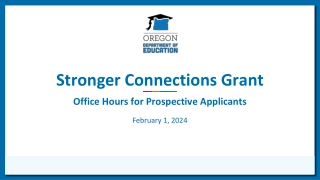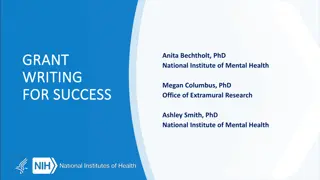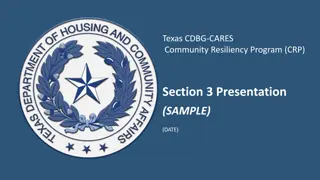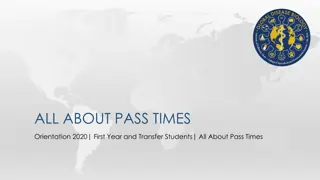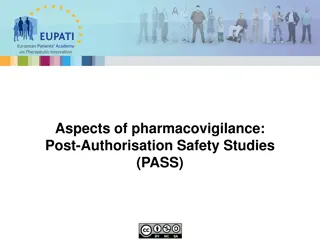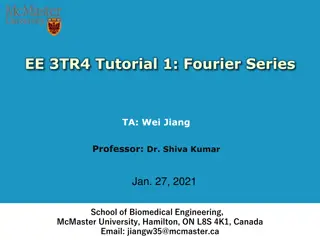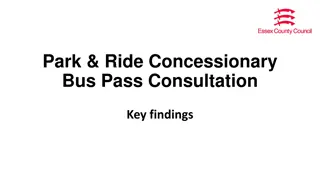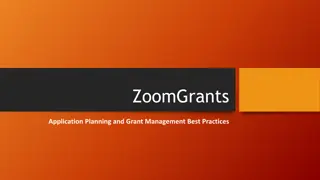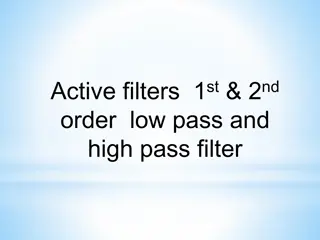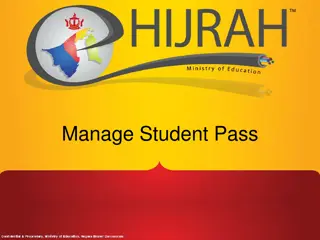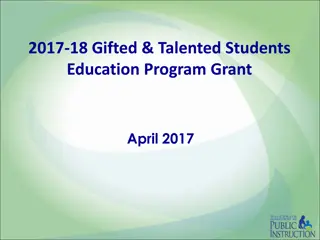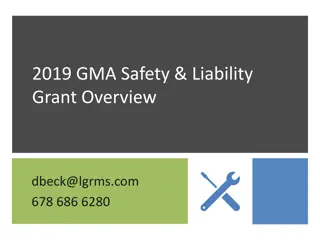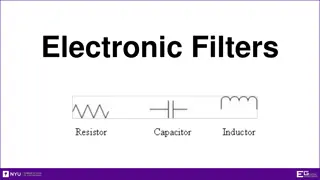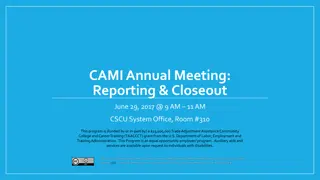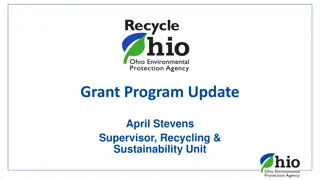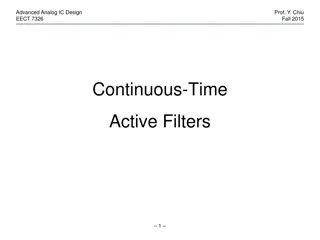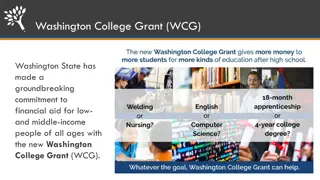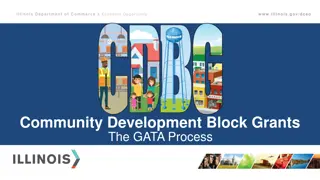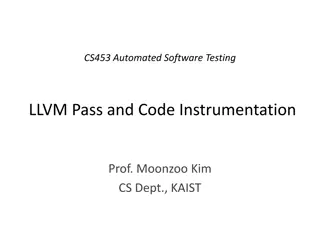Annual Pass-Through Grant Training Overview
This training session covers important topics related to annual pass-through grants, including roles of key departments, system requirements, grant agreements, reimbursement processes, documentation requirements, and contact information. Participants are advised to keep their phones on mute during the session and can ask questions via phone or WebEx chat. The session emphasizes following federal and state laws and the policies of relevant departments for successful grant management.
Download Presentation

Please find below an Image/Link to download the presentation.
The content on the website is provided AS IS for your information and personal use only. It may not be sold, licensed, or shared on other websites without obtaining consent from the author. Download presentation by click this link. If you encounter any issues during the download, it is possible that the publisher has removed the file from their server.
E N D
Presentation Transcript
1 ANNUAL PASS-THROUGH GRANT TRAINING DNR Office of Management and Budget Services
Housekeeping Items 2 To avoid background noise, please keep your phone on mute unless you are asking a question. We will pause for questions at the end of each section. Questions can be asked via phone or the WebEx chat feature. Chat questions need to be sent to Everyone (select in drop-down box) in order for us to see them. This power point will be available on our website later today. Please follow-up with your assigned Grants Specialist on any individual questions or questions that occur to you after the training has concluded.
Topics to be Covered 3 Introduction Roles of LCCMR/LSOHC & the DNR Grants Unit System Requirements (Q & A) Grant Agreement Grant Agreement Attachments Project Reimbursement (Q & A) Forms Documentation Work Plans/Reports Documentation Kept on File (Q & A) Contact Information
Introduction (continued...) 4 The manual is based on federal and state laws, and policies and procedures of the Minnesota Department of Administration s Office of Grants Management (OGM) and the Minnesota Department of Natural Resources Office of Management and Budget Services. The Reimbursement Manual can be found on our website at: DNR Pass-Through Grants Website For questions regarding the grant agreement, including reimbursement requests, please contact the State s Authorized Representative or your assigned Grants Specialist.
Roles of the DNR & LCCMR/LSOHC 5 LCCMR=Legislative-Citizen Commission of Minnesota Resources LCCMR makes funding recommendations to the legislature for special environment and natural resources projects, primarily from the Environment and Natural Resources Trust Fund (ENRTF)
Roles of the DNR & LCCMR/LSOHC 6 LSOHC=Lessard-Sams Outdoor Heritage Council LSOHC provides annual funding recommendations to the legislature from the Outdoor Heritage Fund (OHF)
Roles of the DNR & LCCMR/LSOHC 7 LCCMR/LSOHC oversee your project(s) LCCMR/LSOHC take in the proposals and make recommendations to legislature All work/accomplishment plan amendments and budget amendments must be approved by the LCCMR/LSOHC Status reports are approved by the LCCMR/LSOHC
Roles of the DNR & LCCMR/LSOHC 8 The DNR Grants Unit: Oversees your contract(s) and payments Verifies that expenses are eligible for reimbursement by determining if they are included in your approved work/accomplishment plan and budget Amends your contract(s), if necessary Ensures grantees are current on meeting reporting requirements before making payments Monitors grant, fiscal management and contract compliance
Roles of the DNR & LCCMR/LSOHC 9 DNR Grants Unit and LCCMR/LSOHC work together to make sure project goals, contractual obligations, state laws, and reporting requirements are being met for all Trust Fund and Outdoor Heritage Fund appropriations
Roles of the DNR & LCCMR/LSOHC 10 LCCMR website LSOHC website
System Requirements 11 Electronic Funds Transfer SWIFT e-Supplier Portal
Electronic Funds Transfer 12 The preferred and most efficient method of payment is an electronic funds transfer (EFT) directly into the grantee s designated bank account. Once a payment is made to the grantee, it generally takes 2-3 business days for the funds to appear in the grantee s account. Please make sure your banking information is current and up-to-date in SWIFT.
SWIFT e-Supplier Portal 13 Vendor Resources are available at SWIFT Vendor Resources Website MMB helpline (651) 201-8106 or EFT Helpline Email Address
Grant Agreements #1 15 Expiration Date - can vary depending on the following (Availability of Appropriation): Project receives a federal grant Acquisition-binding contract language Restoration and Enhancement Carry-forward language 1. 2. 3. 4. Incurring Expenses (Payment Conditions)- grantee can not incur expenses until July 1, 2015 or the date the work/accomplishment plan is approved, whichever is later
Grant Agreements #2 16 Funds are paid on a reimbursement basis (Payment Conditions) Authorized Representative - if this changes, you must notify the state Payment requests should be submitted on a regular basis Grant documentation is subject to a state audit for six years following the grant expiration date (M.S. 16C.05, Subd. 5)
Grant Agreements #3 17 Appropriation recipients must acknowledge financial support from the funds in program publications, signage, and other public communication and outreach related to work completed using the appropriation At least one monitoring visit per grant period on all state grants of over $50,000 will be conducted and at least annual monitoring visits on grants of over $250,000 (OGM Policy 08-10) If your project involves work with invasive species, pollinator, or restoration, be sure to review the appropriate clauses in the grant contract.
Grant Agreements #4 18 Subcontracting NGOs must follow the DNR s procurement policy or have their own policy approved by the DNR. Municipalities must follow Uniform Municipal Contracting Law. The subcontract agreement must contain all provisions of the grant agreement the Grantee has with the state 1. 2. 3. Grantee must comply with the most current versions of: Attachment D (Reimbursement Manual) Attachment E (Land Acquisition Requirements) and Attachment F (updates to state laws and statutes) 1. 2. 3.
Grant Agreements 19 Questions
Grant Agreement Attachments 21 Grant Agreement Attachments Attachment A-Initial Approved Work/Accomplishment Plan Attachment B- Non-Governmental Organization Subcontracting (if applicable) Attachment C- Conflict of Interest Disclosure Attachment D- Reimbursement Manual Attachment E- Land Acquisition Reporting Procedures Attachment F- Additional Reporting Requirements
Grant Agreement Attachments 22 Attachment A- Initial Approved Work/Accomplishment Plan Initial work/accomplishment plan associated with your grant agreement as approved by the LCCMR/LSOHC LCCMR LSOHC
Subcontracting Policy 23 Attachment B- Non-Governmental Organization Subcontracting (if applicable) NGOs must follow the state s subcontracting policy or you can choose an alternate policy that must be approved by the DNR Grants Unit Municipalities are exempt from Attachment B Non-Governmental Organization Subcontracting Form (Attachment B)
Grant Agreement Attachments 24 Attachment B- Non-Governmental Organization Subcontracting (if applicable) Subcontractors include other organizations and/or businesses that perform services identified in the work/accomplishment plan Vendors provide supplies or materials to the project Both must be selected based on contracting/purchasing procedures outlined in the current reimbursement manual Transparency, fiscal control and accountability are key reasons why the State requires grantees to be thorough in the solicitation and selection of subcontractors and vendors
Solicitation and Selection #1 25 The following guidelines should be used by NGOs if they intend to follow the DNR s procurement guidelines: Grantees shall retain copies of executed subcontracts and bid tabulation on file along with written documentation that describes the rationale for selection of the subcontractor Any services and/or materials that are expected to cost $20,000 or more must undergo a formal notice and bidding process. Any services and/or materials that are expected to cost between $10,000 and $19,999 must be scoped out in writing and offered to a minimum of three (3) bidders. Any services and/or materials that are expected to cost between $5,000 and $9,999 must be competitively based on a minimum of three (3) verbal quotes. 1. 2. 3. 4.
Solicitation and Selection #2 26 Support documentation of the bidding process utilized to contract services must be included in the grantee s financial records, including support documentation justifying a single/sole source bid, if applicable. 5. For projects that include construction work of $25,000 or more, prevailing wage rules apply per Minnesota Statue 177.41 through 177.44. Consequently, the bid request must state the project is subject to prevailing wage. These rules require that the wages of laborers and workers should be comparable to wages paid for similar work in the community as a whole. A prevailing wage form should accompany these bid submittals. 6. Grantees must use a Request for Proposal (RFP)/Request for Quote (RFQ) process to competitively select professional and technical services 7. The advertisement for bid processes must allow for fair competition among potential qualified bidders. 8. Grantee must verify the vendor/subcontractor is not on the State s debarment list: Debarment List Website 9.
Solicitation and Selection #3 27 10. Single/sole source contracts: It is the policy of the State of Minnesota (Policy 08-07: Single and Sole Source Grants) that grants are to be competitively awarded as much as possible. Single and sole source grants are to be used when only one entity is reasonably able to meet a grant s intended purpose and objectives, due to their geographic location, specialized knowledge, relationships or specialized equipment. The following template should be used: Grant Single Source Justification Form. The Grantee should send in their signed form to the State s authorized representative for consideration of approval. If approved, the Grantee must keep the executed copy on file.
Subcontracting Policy: Municipalities #1 28 Per Minnesota Statute 471.345, municipalities as defined in Subd. 1 must follow that Uniform Municipal Contracting Law if contracting funds from this grant contract agreement for any supplies, materials, equipment, or the rental thereof, or the construction, alteration, repair, or maintenance of real or personal property. 1. If the amount of the contract is estimated to exceed $100,000, a formal notice and bidding process must be conducted in which sealed bids shall be solicited by public notice. Municipalities may, as a best value alternative, award a contract for construction, alteration, repair, or maintenance work to the vendor or contractor offering the best value under a request for proposals as described in Minnesota Statute 16C.28, Subd. 1, paragraph a, clause 2. 2.
Subcontracting Policy: Municipalities #2 29 If the amount of the contract is estimated to exceed $25,000, but not $100,000, the contract may be made either upon sealed bids or by direct negotiation, by obtaining two or more quotations for the purchase or sale when possible, and without advertising for bids or otherwise complying with the requirements of competitive bidding. All quotations obtained shall be kept on file for a period of at least one year after receipt thereof. Municipalities may, as a best value alternative, award a contract for construction, alteration, repair, or maintenance work to the vendor or contractor offering the best value under a request for proposals as described in Minnesota Statute 16C.28, Subd. 1, paragraph a, clause 2, and paragraph c. 3. If the amount of the contract is estimated to be $25,000 or less, the contract may be made either upon quotation or in the open market, in the discretion of the governing body. If the contract is made upon quotation it shall be based, so far as practicable, on at least two quotations which shall be kept on file for a period of at least one year after their receipt. Alternatively, municipalities may award a contract for construction, alteration, repair, or maintenance work to the vendor or contractor offering the best value under a request for proposals as described in Minnesota Statute 16C.28, Subd. 1, paragraph a, clause 2. 4.
Subcontracting Policy: Municipalities #3 30 Support documentation of the bidding process utilized to contract services must be included in the grantee s financial records, including support documentation justifying a single/sole source bid, if applicable. 5. For projects that include construction work of $25,000 or more, prevailing wage rules apply per Minnesota Statue 177.41 through 177.44. Consequently, the bid request must state the project is subject to prevailing wage. These rules require that the wages of laborers and workers should be comparable to wages paid for similar work in the community as a whole. A prevailing wage form should accompany these bid submittals. 6.
Materials and Services #1 31 Materials and services purchased by the grantee to achieve outcomes/activities stated in the work/accomplishment plan are eligible project expenditures Typical examples of material/service purchases include hardware, paint, lumber, sand/gravel, concrete, landscape materials, signs, design/engineering services and subcontractor services. 1. Professional service rates require written documentation to justify the reason for the rate, how it was calculated, and the services included in the rate. 2.
Materials and Services #2 32 An invoice must be obtained from the vendor to provide evidence of the sale/service whenever the grantee purchases materials or services. 3. The invoice and the copy sent in with the reimbursement request must be legible and include the following items: 4. Name and address of the vendor Date the item or service was purchased Date the service was performed Quantity of item(s) purchased or hours worked Description of item(s) or services purchased Unit price/Prorate Total amount of each line item
Grant Agreement Attachments 33 Attachment C- Conflict of Interest Disclosure Grantee must maintain a conflict of interest policy throughout the term of the grant agreement Conflict of Interest Disclosure Form
Grant Agreement Attachments 34 Attachment D- Reimbursement Manual Reimbursement Manual
Grant Agreement Attachments 35 Attachment E- Land Acquisition Reporting Requirements Required documentation for land acquisitions Attachment E-ENRTF Attachment E-OHF
Land Acquisition Requirements #1 36 The latest version (July 2015) of Attachment E had several changes including: Closing on a property should happen within one year of executing the purchase agreement. We ask that you contact your Grants Specialist if you do not anticipate this being possible on an acquisition 1. A summary appraisal report use to be an option for properties valued at $20,001- $99,999. That is no longer an option in the newest USPAP guidelines so all properties valued at over $20,000 must have an appraisal completed by a Certified General Level 4 appraiser licensed in Minnesota. 2. The grant recipient must provide the appraiser with not only a full legal description, but also an estimate of the acreage of the property being acquired. 3. Appraisal reviews must be completed prior to submitting a request for reimbursement and it is recommended they are completed prior to obtaining an executed purchase agreement. 4.
Land Acquisition Requirements #2 37 Attachment E: Trust Fund 1. Acquisitions specifically identified in appropriation law are not subject to commissioner approval. All other ENRTF acquisitions require completion of the Commissioner approval form prior to purchase Appropriation recipients must submit the most recent tax assessed value, most recent tax statement of the real property, and the amount the recipient plans to offer for the interest in real property to LCCMR and the commissioner of natural resources at least ten business days prior to acquiring an interest in real property with an appropriation from the Trust Fund 2.
Land Acquisition Requirements #3 38 Attachment E: Trust Fund 3. The Recipient will not be entitled to use funds available under this Agreement (alone or in combination with other funds) for a land purchase price in excess of the appraised value. Up to 110% of appraised value may be approved following review by the LCCMR. Attachment E: Outdoor Heritage Fund Changes Only 1. Documentation of revenues for land transferred to the state must be submitted within 60 days after the closing date
Land Acquisition Requirements #4 39 If an acquisition requires preliminary work performed by the DNR such as an appraisal review, it is important that an Use of Funds Letter is submitted well in advance and that funding is available in the DNR Land Acquisition Costs (OHF) or Other DNR acquisition, reporting, and management (ENRTF) line item of the approved work/accomplishment plan
Land Acquisition Requirements #5 40 All pre-closing documentation that is required per Attachment E must be submitted at least 10 business days prior to close to ensure the documents can be reviewed and the payment can be delivered Grantees have the option of having funds wired directly to their title company the morning of the closing or funds electronically transferred into their SWIFT account one day prior to closing
Land Acquisition Requirements #6 41 All parcels that are being acquired must be listed in the most current, recently approved work/accomplishment plan For appraisal related questions, please contact the DNR s Appraisal Management Unit Supervisor Cindy Nathan at 218-203-4408
Grant Agreement Attachments 42 Attachment F- Minnesota laws and statutes that pertain to FY16 ENRTF and OHF Projects ENRTF (LCCMR) ML 2015, Chapter 76, Section 2 Land Acquisition Restrictions M.S. 116P.15 Real Property Interest Report M.S. 116P.16 DNR Commissioner Approval on all ENRTF Land Acquisitions M.S. 116P.17 Lands in Public Domain M.S. 116P.18 1. 2. 3. 4. 5.
Grant Agreement Attachments 43 Attachment F- Minnesota laws and statutes that pertain to FY16 ENRTF and OHF Projects OHF (LSOHC) ML 2015, 1st Special Session, Chapter 2, Article 1, Section 2 1. Outdoor Heritage Fund and the Lessard-Sams Outdoor Heritage Council M.S. 97A.056 2.
Grant Agreement Attachments 44 Questions
Project Reimbursement 45 Project Reimbursement Definition Reimbursement Request Reimbursement Documentation
Project Reimbursement 46 Reimbursements are made by the State upon receiving: 1) Demonstration that deliverables in the approved Work/Accomplishment Plan have been achieved 2) Documentation of eligible expenses 3) Proof of payment (when applicable) Note: Any expenditure submitted for reimbursement must be direct and necessary for the project and have been incurred during the grant period.
Project Reimbursement (continued) 47 Grantee pays for expenses prior to seeking reimbursement Advance payment with prior (board) approval only. Board approval is not needed for a transfer of funds in your SWIFT account one day prior to a land acquisition closing or a wire transfer to your title company the morning of your closing. Total $ reimbursed cannot exceed the total award $ Grantees should expect payment within 30 days of the DNR receiving a reimbursement request as long as all the proper documentation has been submitted.
Reimbursement Request 48 The Reimbursement request is comprised of four sections: Section 1: Project Reimbursement Payment Request Form Section 2: Reimbursement Spreadsheets Section 3: Project Activity Summary Spreadsheet Section 4: Reimbursement Documentation These documents are provided with the Reimbursement Manual
Reimbursement Payment Request Form 49 Section 1: Project Reimbursement Payment Request Form Section 1: SWIFT PO Number: Request Number _________________ Period for which funds are being requested: From: _____/_____/_____ To: _____/____/______ Amount of Request Grantee: Project Name: I certify that I am authorized to request funds, and that all services rendered, materials purchased, and expenditures reported are as shown in the attached reimbursement forms. I certify that the expenditures reported have been incurred, are not being reimbursed from another source, and were used exclusively for this project. All original documentation is retained by the grantee in the form of invoices, proof of payment, and signed time records. Copies of these supporting documents are attached as required by State grant management policies. Signature _____________________________________________________ Name, Title Daytime Phone Number: ________________________________ E-Mail: ______________________________________________ Required for all payment requests including acquisition. The form must be signed by someone who is authorized to submit reimbursement payment requests on behalf of your organization. Note: The period for which funds are being requested can be the earliest and latest dates that costs were incurred or the time period this request covers. Date $ _______________ Final Request: Y / N Remarks: For DNR Use Only I have reviewed the evidence provided by the grantee for the goods, materials and/or services presented and they satisfy State requirements for reimbursement under the pass through agreement. Reimbursement approved for: $ ______________ Date Received By: ____________________________________ Title: ________________________________ Date: _______________ 2nd Review By: ___________________________________ Title: ________________________________ Date: _______________ Please keep originals of invoices and evidence of payment as documentation for payments, along with a copy of this completed form. Records must be retained for six (6) years from the end of the agreement.
Reimbursement Spreadsheet 50 Section 2: Provides a snapshot of the grant status including the starting budget, current requested reimbursement amount, and the remaining balance Note: The starting budget must be reflected in the latest approved Work/Accomplishment Plan. Only approved budget items are eligible for reimbursement.



